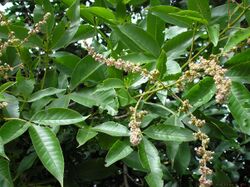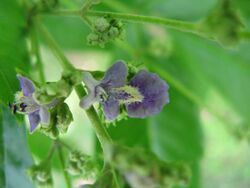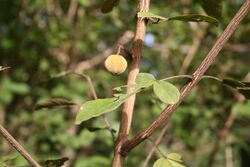Vitex
Topic: Biology
 From HandWiki - Reading time: 4 min
From HandWiki - Reading time: 4 min
| Vitex | |
|---|---|

| |
| Vitex altissima | |
| Scientific classification | |
| Kingdom: | Plantae |
| Clade: | Tracheophytes |
| Clade: | Angiosperms |
| Clade: | Eudicots |
| Clade: | Asterids |
| Order: | Lamiales |
| Family: | Lamiaceae |
| Subfamily: | Viticoideae |
| Genus: | Vitex L.[1] |
| Type species | |
| Vitex agnus-castus | |
| Diversity | |
| About 250 species | |
| Synonyms[2] | |
| |
Vitex /ˈvaɪtɛks/[3] is a genus of flowering plants in the sage family Lamiaceae. It has about 250 species.[4][5] Common names include chaste tree or chastetree, traditionally referring to V. agnus-castus, but often applied to other species, as well.
Species of Vitex are native throughout the tropics and subtropics, with a few species in temperate Eurasia and one in New Zealand.[2][6]
About 18 species are known in cultivation. V. agnus-castus and Vitex negundo are often grown in temperate climates.[7] About six others are frequently grown in the tropics.[8] Most of the cultivated species serve as ornamentals. Some provide valuable lumber. The flexible limbs of some species are used in basket weaving.[6] Some of the aromatic species are used medicinally[8][9] or to repel mosquitos.[8]
The genus Vitex was named by Linnaeus in Species Plantarum in 1753.[10] Vitex was the name used by Pliny the Elder for V. agnus-castus. It is derived from the Latin vieo, meaning to weave or to tie up, a reference to the use of V. agnus-castus in basketry.[11]
As a result of phylogenetic studies of DNA sequences, Vitex is one of several genera that were transferred from the Verbenaceae to the Lamiaceae in the 1990s. It is the largest genus in the subfamily Viticoideae of Lamiaceae.[4] Taxon sampling in molecular phylogenetic studies has never been sufficient to test the monophyly of the Viticoideae, but it is generally thought to be an unnatural group.[12] The subfamily is probably diphyletic, with Premna, Gmelina, and Cornutia constituting one clade, and with Vitex, Petitia, Pseudocarpidium, and Teijsmanniodendron constituting the other.[13]
Description
Vitex is a genus of shrubs and trees, from 1.0 to 35 m tall. Some species have whitish bark that is characteristically furrowed. Leaves are opposite, usually compound. The fruit is a drupe.[14]
Circumscription
In 2009, a molecular phylogenetic study showed that three small genera, Paravitex, Viticipremna, and Tsoongia, are embedded in Vitex. These three genera were duly sunk into synonymy with Vitex.[13]
Pseudocarpidium, Petitia, and Teijsmanniodendron possibly are nested within Vitex. Sampling in the 2009 study was not sufficient to determine the phylogenetic position of these genera. The relationships of Teijsmanniodendron to these genera was not discussed in a revision of Teijsmanniodendron in 2009.[15]
Selected species
- Vitex acunae
- Vitex agnus-castus — chasteberry, monk's pepper, chastetree
- Vitex ajugaeflora
- Vitex altissima
- Vitex amaniensis
- Vitex capitata
- Vitex chrysocarpa
- Vitex cofassus
- Vitex cooperi
- Vitex cymosa
- Vitex divaricata
- Vitex doniana — wild African black plum, koronfinfin
- Vitex evoluta
- Vitex gaumeri
- Vitex gigantea
- Vitex heptaphylla
- Vitex keniensis — Meru oak
- Vitex kuylenii
- Vitex lehmbachii
- Vitex leucoxylon
- Vitex lignum-vitae — yellow hollywood, lignum-vitae
- Vitex lindenii
- Vitex longisepala
- Vitex lucens — pūriri
- Vitex megapotamica
- Vitex negundo — five-leaf chastetree
- Vitex obovata
- Vitex orinocensis
- Vitex parviflora — Molave tree
- Vitex peduncularis
- Vitex pinnata
- Vitex quinata
- Vitex rotundifolia — beach vitex
- Vitex thyrsiflora
- Vitex triflora
- Vitex trifolia — simpleleaf chastetree
- Vitex tripinnata
- Vitex urceolata
- Vitex yaundensis
- Vitex zanzibarensis
- Vitex zeyheri
References
- ↑ "Genus: Vitex L.". Germplasm Resources Information Network. United States Department of Agriculture. 2004-09-10. http://www.ars-grin.gov/cgi-bin/npgs/html/genus.pl?12733.
- ↑ 2.0 2.1 Kew World Checklist of Selected Plant Families
- ↑ Vitex (3rd ed.), Oxford University Press, September 2005, http://oed.com/search?searchType=dictionary&q=Vitex (Subscription or UK public library membership required.)
- ↑ 4.0 4.1 Raymond M. Harley, Sandy Atkins, Andrey L. Budantsev, Philip D. Cantino, Barry J. Conn, Renée J. Grayer, Madeline M. Harley, Rogier P.J. de Kok, Tatyana V. Krestovskaja, Ramón Morales, Alan J. Paton, and P. Olof Ryding. 2004. "Labiatae" pages 167-275. In: Klaus Kubitzki (editor) and Joachim W. Kadereit (volume editor). The Families and Genera of Vascular Plants volume VII. Springer-Verlag: Berlin; Heidelberg, Germany. ISBN:978-3-540-40593-1
- ↑ Vitex In: Index Nominum Genericorum. In: Regnum Vegetabile (see External links below).
- ↑ 6.0 6.1 David J. Mabberley. 2008. Mabberley's Plant-Book third edition (2008). Cambridge University Press: UK.
- ↑ Anthony J. Huxley, Mark Griffiths, and Margot Levy (editors). 1992. The New Royal Horticultural Society Dictionary of Gardening. The Macmillan Press Limited, London; The Stockton Press, New York.
- ↑ 8.0 8.1 8.2 George W. Staples and Derral R. Herbst "A Tropical Garden Flora" Bishop Museum Press: Honolulu (2005)
- ↑ "Elemental and Phytochemical Screening of Vitex Doniana Leaves and Stem Bark in Hong Local Government Area of Adamawa State, Nigeria". International Journal of Chemical Studies 1 (3): 165–172. 2013. http://www.chemijournal.com/vol1Issue3/sep2013/43.1.pdf.
- ↑ Carolus Linnaeus. 1753. Species Plantarum 2:706. Laurentii Salvii. (see External Links below).
- ↑ Umberto Quattrocchi. 2000. CRC World Dictionary of Plant Names volume I, page 91. CRC Press: Boca Raton; New York; Washington, DC;, US. London, UK. ISBN:978-0-8493-2673-8 (set). (see External links below).
- ↑ 13.0 13.1 Gemma L.C. Bramley, Félix Forest, and Rogier P.J. de Kok. 2009. "Troublesome tropical mints: re-examining generic limits of Vitex and relations (Lamiaceae) in South East Asia". Taxon 58(2):500-510.
- ↑ "Vitex Linn.". Manual of the New Zealand Flora. http://nzetc.victoria.ac.nz/tm/scholarly/tei-CheManu-t1-body1-d58-d2.html.
- ↑ Rogier P.J. de Kok, Go Rusea, and Abdul Latiff. 2009. "The Genus Teijsmanniodendron Koord. (Lamiaceae)". Kew Bulletin 64(4):587-625.
Further reading
- Ray Harley, "In search of Labiatae in Eastern Brazil", Vitex: A Newsletter for Lamiaceae and Verbenaceae Research, ISSN 1470-0123, Issue 1, February 2000, page 5.
External links
- List of Genera in Lamiaceae, Missouri Botanical Garden
- Vitex, Index Nominum Genericorum
- Vitex in Biodiversity Heritage Library
- CRC World Dictionary of Plant Names: R-Z
- Systematics of Lamiaceae Subfamily Viticoideae
Wikidata ☰ Q132607 entry
 |
 KSF
KSF


